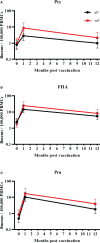Memory B Cell Activation Induced by Pertussis Booster Vaccination in Four Age Groups of Three Countries
- PMID: 35677044
- PMCID: PMC9168128
- DOI: 10.3389/fimmu.2022.864674
Memory B Cell Activation Induced by Pertussis Booster Vaccination in Four Age Groups of Three Countries
Abstract
Background: Immunogenicity of acellular pertussis (aP) vaccines is conventionally assessed by measuring antibody responses but antibody concentrations wane quickly after vaccination. Memory B cells, however, are critical in sustaining long-term protection and therefore may be an important factor when assessing pertussis immunity after vaccination.
Aim: We studied pertussis specific memory B cell (re)activation induced by an aP booster vaccination in four different age groups within three countries.
Materials and methods: From a phase IV longitudinal interventional study, 268 participants across Finland, the Netherlands and the United Kingdom were included and received a 3-component pertussis booster vaccine: children (7-10y, n=53), adolescents (11-15y, n=66), young adults (20-34y, n=74), and older adults (60-70y, n=75). Memory B cells at baseline, day 28, and 1 year post-vaccination were measured by a pertussis toxin (Ptx), filamentous haemagglutinin (FHA), and pertactin (Prn) specific ELISpot assay. Antibody results measured previously were available for comparison. Furthermore, study participants were distributed into groups based on their baseline memory B cell frequencies, vaccine responses were monitored between these groups.
Results: Geometric mean (GM) memory B cell frequencies for pertussis antigens at baseline were low. At 28 days post-vaccination, these frequencies increased within each age group and were still elevated one year post-booster compared to baseline. Highest frequencies at day 28 were found within adolescents (GM: 5, 21, and 13, for Ptx, FHA and Prn, respectively) and lowest within older adults (GM: 2, 9, and 3, respectively). Moderate to strong correlations between memory B cell frequencies at day 28 and antibody concentrations at day 28 and 1 year were observed for Prn. Memory B cell frequencies > 1 per 100,000 PBMCs at baseline were associated with significantly higher memory responses after 28 days and 1 year.
Conclusions: An aP booster vaccine (re)activated memory B cells in all age groups. Still elevated memory B cell frequencies after one year indicates enhanced immunological memory. However, antigen specific memory B cell activation seems weaker in older adults, which might reflect immunosenescence. Furthermore, the presence of circulating memory B cells at baseline positively affects memory B cell responses. This study was registered at www.clinicaltrialsregister.eu: No. 2016-003678-42.
Keywords: pertussis; adolescents; adults; children; longitudinal; memory B cells; older adults; vaccination.
Copyright © 2022 Versteegen, Barkoff, Valente Pinto, van de Kasteele, Knuutila, Bibi, de Rond, Teräsjärvi, Sanders, de Zeeuw-Brouwer, Luoto, ten Hulscher, Clutterbuck, Sanders, Mertsola, Berbers, He, Kelly, Buisman and PERISCOPE Consortium.
Conflict of interest statement
The authors declare that the research was conducted in the absence of any commercial or financial relationships that could be construed as a potential conflict of interest.
Figures





Similar articles
-
Responses to an acellular pertussis booster vaccination in children, adolescents, and young and older adults: A collaborative study in Finland, the Netherlands, and the United Kingdom.EBioMedicine. 2021 Mar;65:103247. doi: 10.1016/j.ebiom.2021.103247. Epub 2021 Feb 26. EBioMedicine. 2021. PMID: 33647770 Free PMC article. Clinical Trial.
-
Association of baseline cytokines with antibody concentrations after diphtheria-tetanus-acellular pertussis booster vaccination in Finnish children.Vaccine. 2025 Jan 12;44:126573. doi: 10.1016/j.vaccine.2024.126573. Epub 2024 Nov 30. Vaccine. 2025. PMID: 39616006
-
Impact of infant and preschool pertussis vaccinations on memory B-cell responses in children at 4 years of age.Vaccine. 2011 Aug 5;29(34):5725-30. doi: 10.1016/j.vaccine.2011.05.094. Epub 2011 Jun 12. Vaccine. 2011. PMID: 21669247
-
Reduced-antigen, combined diphtheria, tetanus and acellular pertussis vaccine, adsorbed (Boostrix®): a review of its properties and use as a single-dose booster immunization.Drugs. 2012 Sep 10;72(13):1765-91. doi: 10.2165/11209630-000000000-00000. Drugs. 2012. PMID: 22931522 Review.
-
Experience with monocomponent acellular pertussis combination vaccines for infants, children, adolescents and adults--a review of safety, immunogenicity, efficacy and effectiveness studies and 15 years of field experience.Vaccine. 2013 Oct 25;31(45):5178-91. doi: 10.1016/j.vaccine.2013.08.034. Epub 2013 Aug 28. Vaccine. 2013. PMID: 23994021 Review.
Cited by
-
Effect of immunization during pregnancy and pre-existing immunity on diphtheria-tetanus-acellular pertussis vaccine responses in infants.Emerg Microbes Infect. 2023 Dec;12(1):2204146. doi: 10.1080/22221751.2023.2204146. Emerg Microbes Infect. 2023. PMID: 37060181 Free PMC article.
-
Clinical and Epidemiological Characteristics of Pediatric Pertussis Cases: A Retrospective Study from Southeast Romania.Antibiotics (Basel). 2025 Apr 23;14(5):428. doi: 10.3390/antibiotics14050428. Antibiotics (Basel). 2025. PMID: 40426495 Free PMC article.
-
The whole-cell pertussis vaccine imposes a broad effector B cell response in mouse heterologous prime-boost settings.JCI Insight. 2022 Nov 8;7(21):e157034. doi: 10.1172/jci.insight.157034. JCI Insight. 2022. PMID: 36136586 Free PMC article.
-
Booster Immunization Improves Memory B Cell Responses in Older Adults Unresponsive to Primary SARS-CoV-2 Immunization.Vaccines (Basel). 2023 Jul 4;11(7):1196. doi: 10.3390/vaccines11071196. Vaccines (Basel). 2023. PMID: 37515012 Free PMC article.
-
Antibody avidity to pertussis toxin after acellular pertussis vaccination and infection.Emerg Microbes Infect. 2023 Dec;12(1):e2174782. doi: 10.1080/22221751.2023.2174782. Emerg Microbes Infect. 2023. PMID: 36715361 Free PMC article.
References
Publication types
MeSH terms
Substances
LinkOut - more resources
Full Text Sources

